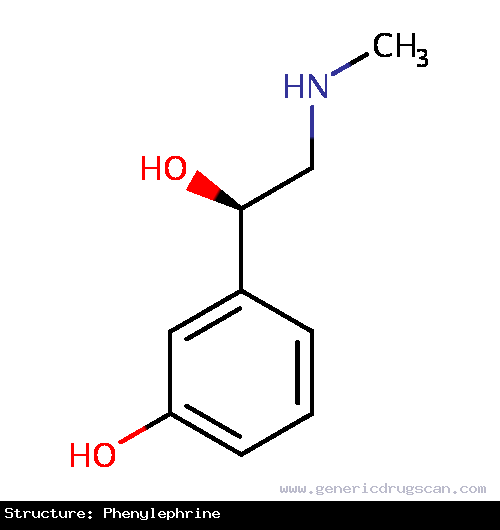Phenylephrine Drug: Indication, Dosage, Precaution, Side Effect , Storage, Category Type and corresponding Brands - www.genericdrugscan.com
Phenylephrine
Drug Status in USA : ApprovedDrug Status in Canada : Approved
pronunciation
pronounced as (fen il ef' rin)
Why is this medication prescribed?
Phenylephrine is used to relieve nasal discomfort caused by colds, allergies, and hay fever. It is also used to relieve sinus congestion and pressure. Phenylephrine will relieve symptoms but will not treat the cause of the symptoms or speed recovery. Phenylephrine is in a class of medications called nasal decongestants. It works by reducing swelling of the blood vessels in the nasal passages.
How should this medicine be used?
Phenylephrine comes as a tablet, a liquid, or a dissolving strip to take by mouth. It is usually taken every 4 hours as needed. It is also available in extended release forms that are usually taken one or two times a day. Follow the directions on your prescription label or the package label carefully, and ask your doctor or pharmacist to explain any part you do not understand. Take phenylephrine exactly as directed. Do not take more or less of it or take it more often than prescribed by your doctor or directed on the label.
Phenylephrine comes alone and in combination with other medications. Ask your doctor or pharmacist for advice on which product is best for your symptoms. Check nonprescription cough and cold product labels carefully before using two or more products at the same time. These products may contain the same active ingredient(s) and taking them together could cause you to receive an overdose. This is especially important if you will be giving cough and cold medications to a child.
Nonprescription cough and cold combination products, including products that contain phenylephrine, can cause serious side effects or death in young children. Do not give these products to children younger than 4 years of age. If you give these products to children 4 to 11 years of age, use caution and follow the package directions carefully.
If you are giving phenylephrine or a combination product that contains phenylephrine to a child, read the package label carefully to be sure that it is the right product for a child of that age. Do not give phenylephrine products that are made for adults to children.
Before you give a phenylephrine product to a child, check the package label to find out how much medication the child should receive. Give the dose that matches the child's age on the chart. Ask the child's doctor if you don't know how much medication to give the child.
If you are taking the liquid, do not use a household spoon to measure your dose. Use the measuring spoon or cup that came with the medication or use a spoon made especially for measuring medication.
If your symptoms do not get better within 7 days or if you have a fever, stop taking phenylephrine and call your doctor.
If you are taking the dissolving strips, place one strip on your tongue and allow it to dissolve.
What are the precautions to be followed?
Before taking phenylephrine,- tell your doctor and pharmacist if you are allergic to phenylephrine or any other medications.
- do not take phenylephrine if you are taking a monoamine oxidase (MAO) inhibitor, such as isocarboxazid (Marplan), phenelzine (Nardil), selegiline (Eldepryl, Emsam, Zelapar), and tranylcypromine (Parnate), or if you have stopped taking one of these medications within the past 2 weeks.
- tell your doctor and pharmacist what other prescription and nonprescription medications, vitamins, nutritional supplements, and herbal products you are taking or plan to take.
- tell your doctor if you have or have ever had high blood pressure, diabetes, trouble urinating because of an enlarged prostate gland, or thyroid or heart disease.
- tell your doctor if you are pregnant, plan to become pregnant, or are breast-feeding. If you become pregnant while taking phenylephrine, call your doctor.
- if you are having surgery, including dental surgery, tell the doctor or dentist that you are taking phenylephrine.
- if you have phenylketonuria (PKU, an inherited condition in which a special diet must be followed to prevent mental retardation), you should know that some phenylephrine products may be sweetened with aspartame, a source of phenylalanine.
What are possible side effects of this medication ?
Phenylephrine may cause side effects. Some side effects can be serious. If you experience any of these symptoms, stop using phenylephrine and call your doctor:- nervousness
- dizziness
- sleeplessness
Phenylephrine may cause other side effects. Call your doctor if you have any unusual problems while taking this medication.
How to store the medication and dispose it of after its use later?
Keep this medication in the container it came in, tightly closed, and out of reach of children. Store it at room temperature and away from excess heat and moisture (not in the bathroom).
Unneeded medications should be disposed of in special ways to ensure that pets, children, and other people cannot consume them. However, you should not flush this medication down the toilet. Instead, the best way to dispose of your medication is through a medicine take-back program.
Drug Category/Class
- Adrenergic alpha-1 Receptor Agonists
- Mydriatics
- Nasal Decongestants
- Sympathomimetics
- Vasoconstrictor Agents
- Adrenergic and Dopaminergic Agents
- Cardiac Stimulants Excl. Cardiac Glycosides
- Sympathomimetics, Plain
- Nasal Decongestants for Systemic Use
- Sympathomimetics Excl. Antiglaucoma Preparations
- Mydriatics and Cycloplegics
- Ophthalmologicals
- Sensory Organs
- Sympathomimetics
| Prescribed | Phenylephrine is mainly used to treat nasal congestion, but may also be useful in treating hypotension and shock, hypotension during spinal anaesth... |
| Weight : | 167.205 |
| Structure | Phenylephrine |
 | |
| Formula | C9H13NO2 |
Phenylephrine has 12 Brands listed
Search Generic Drugs alphabetically
